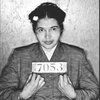Facts by Decade
Facts by Decade
Censuses are not conducted in a vacuum. They occur amidst internal and external crisis, shifts in cultural interests, and events that become "defining moments" for each generation. Census data reflect the growth of the population as well as the changing values and interests of the American people.
Fast Facts provides a portrait of the United States both statistically and culturally. In addition to census-related statistics, the innovations, events, and icons of each decade are highlighted. Each page illustrates the thought and culture of the population counted during each decade's census.
1950
ICONS: Rock & Roll, Civil Rights Movement, Television



Population
| 151,325,798 | U.S. Resident Population |
| 42.6 |
Population per square mile of land area |
| 14.5 |
Percent increase of population from 1940 to 1950 |
| 48 |
Number of States |
10 Largest Urban Places
| Rank |
Place |
Population |
|---|---|---|
| 1 |
New York City, NY | 7,891,957 |
| 2 |
Chicago, IL | 3,620,962 |
| 3 |
Philadelphia, PA | 2,071,605 |
| 4 |
Los Angeles, CA | 1,970,358 |
| 5 |
Detroit, MI | 1,849,568 |
| 6 |
Baltimore, MD | 949,708 |
| 7 |
Cleveland, OH | 914,808 |
| 8 |
St. Louis, MO | 856,796 |
| 9 |
Washington, DC | 802,178 |
| 10 |
Boston, MA | 801,444 |
The 1950 Census
| Cost | $91,462,000 |
| Cost per Capita (cents) | 60.4 |
| Total Pages in Published Reports | 61,700 |
| Number of Enumerators | 142,962 |
| Census Bureau Director | Roy Victor Peel |
| Number of Questions on the Questionnaire | N/A |
| Number of Questions on the Long Form | N/A |
Pop Culture
- RCA broadcasts the first color television program on June 25, 1951.
- Sam Phillips opens the "Sun Records" record label in Memphis, TN, March 27, 1952.
- Francis Crick and James Watson discover the spiral structure of DNA on February 28, 1953, and report the findings in Nature on April 25, 1953.
- Memphis DJ Dewey Phillips introduced radio listeners to Elvis Presley on July 8, 1953, when he played "That's All Right" on his "Red, Hot, and Blue show."
- Ernest Hemingway's The Old Man and the Sea receives a 1953 Pulitzer Prize. In 1954, the author is awarded the Nobel Prize in Literature.
- The USS Nautilus, the first nuclear submarine, launches on January 21, 1954.
- On December 1, 1955, Rosa Parks refuses to vacate her seat aboard a Montgomery, AL, bus.
- Fred Gipson publishes the novel, Old Yeller in 1956 and receives a Newbury Honor in 1957.
- CBS debuts Leave It to Beaver on October 4, 1957.
- Brazil wins its first Federation Internationale de Football Association (FIFA) World Cup, beating Sweden 5-2, on June 29, 1958.
- Alaska and Hawaii become the 49th and 50th states, respectively, in 1959.
- Rod Serling's Twilight Zone begins airing October 2, 1959.
Page Last Revised - October 31, 2023




